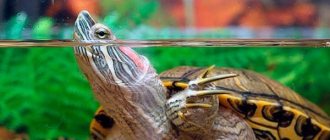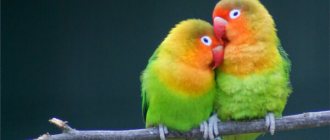Description
The species was discovered in 1904 by Evgeniy Meeka and named Thorichthys ellioti. But later it turned out that this fish had already been described and studied about a hundred years ago and its name was Thorichthys maculipinnis. Breeding and stocking of these fish in European aquariums began in the 1940s. In Russia it began to gain popularity in the 1960s.
Eliot's cichlasoma is a species of fish belonging to the Cichlid family and the Perciformes order.
Aquarists often confuse this species with Meek's cichlasoma, which is similar in color. But upon deeper study, differences between species become visible. For example, Meek's distinctive bright red throat is more pronounced, while Eliot's purple belly is larger. And also Meek's cichlazomas are more schooling animals than Eliot's fish.
Under natural conditions, they live in shallow creeks, lakes or rivers with a weak current or its complete absence. The water should be clean and transparent. In such reservoirs there is a small amount of vegetation; the substrate is dominated by sand and fallen leaves from trees growing nearby.
The species easily adapts to changing conditions, so moving to a new aquarium will not be too stressful for the fish.
Appearance
According to many aquarists, Eliot's cichlid is the most beautiful species among all Cichlids.
But the distinctive bright color often plays a bad role for cichlases. Sometimes unscrupulous sellers deliberately paint fish in bright colors and present it as a new variety bred by breeders. But some time after the purchase, the paint is washed away, the fish turns into a gray creature, sometimes belonging to a different species. And this has a negative effect on the health of the fish.
The Eliot cichlid in an aquarium reaches a size of 14–15 cm, which allows it to be kept in small aquariums. The body is elongated and laterally compressed, resembling an oval in appearance.
Eliot cichlids range in color from gray to orange and blue. There are fish whose main color is olive-beige. Often the body of the fish is zoned, that is, the back is a more neutral beige color, the belly is reddish, and the back is light blue. The color is asymmetrical.
A distinctive feature is bright shiny spots, which become even brighter when exposed to sunlight. These spots do not exceed 1 cm and are located in several rows on the sides. On the head, inclusions sometimes form short lines. There are also spots and thin lines on the anal, ventral, caudal and dorsal fins. The pectoral fins remain transparent. Most often these spots are light blue or azure in color. In some representatives, only parts of the scales are colored, while in others, all the scales are colored. The dorsal fin is decorated with a red edging.
All representatives have a large black spot in the middle of the sides. Sometimes vertical stripes of dark colors are visible from the back to the abdomen or a single horizontal stripe from the eyes to the tail.
The eyes are light, usually blue or yellow. The head is elongated, with a rounded muzzle. The mouth and lips are wide - this helps to search for and swallow large pieces.
Fry and young representatives usually do not have a bright color; it appears as they grow older. Sometimes the full bloom of color occurs before or after spawning.
Behavior
Unlike most representatives of Cichlids, Eliot's cichlid is a slightly aggressive species. Territoriality in fish is not very developed, and rare skirmishes occur only between representatives of their own species. In their natural environment they swim in small schools; during the spawning season they live near the coast and lay their eggs there. Each pair chooses a territory for itself and defends it from other fish. Eliot's Pisces are caring parents.
During the showdown that usually occurs among young representatives, clashes occur. These fish sort things out alone with the enemy, when many species of Cichlids arrange skirmishes with almost the entire school. In Eliot's group, other fish only get into fights if it lasts a long time.
Skirmishes usually occur without much injury. Opponents most often conflict without contact, sometimes accompanying the fight with a tail strike. During skirmishes, their color becomes lighter and brighter. The defeated representative, on the contrary, turns gray, sometimes a bright dark stripe appears on the body.
A complete hierarchy reigns in packs, each member of the group knows his place and his rank. Submission is easily noticeable if you watch the fish. More important fish maintain their status with the help of “slaps” with their tails.
Lifespan
Life expectancy rarely exceeds 15 years, most often representatives live 8–10 years, in nature a little longer.
Cichlazoma black-striped
Cichlazoma black-striped photo can be enlarged
Black-striped cichlids are common in lakes Amatitlan and Atitlan in Guatemala. In natural conditions they reach 10 centimeters in length, in aquariums they are usually smaller.
The structure of their body and fins is the same as that of other representatives of the genus. There are 8 - 9 dark transverse stripes along the gray background on the body. The fins are greenish.
The conditions of keeping and breeding are the same as for other cichlases. The optimal water temperature in the aquarium is 24 - 26°, the minimum is 15°.
In nature, the diet of these fish includes algae and plants, so it is recommended to add plant foods when feeding. Breeding black-striped cichlases is not difficult.
Content
Eliot's fish is considered suitable for beginner aquarists who are ready to devote enough time to their pet and provide comfortable conditions.
The only problem that a novice cich fish breeder may have when keeping Eliot's cichlizoma is the division of the aquarium's territories. Fish, especially when spawning approaches, will defend their zone in fights. Buy large stones and place them on the bottom, dividing the aquarium into approximately equal parts. Typically, cichlids draw boundaries along raised protrusions.
The water must be replaced by 1/3 of the volume weekly, and the aquarium must be cleaned several times a month.
Aquarium
The aquarium space should externally remind cichlids of their natural habitats. The minimum aquarium size for 2 fish is 100 liters. For a flock you will need a tank of 300–400 liters.
The design of the aquarium should be convenient for the inhabitants, and only then serve a decorative function. Stone embankments, grottoes, towers, and driftwood are primarily installed to provide the fish with a place to hide.
Water parameters
Cichlozomas are tropical fish, so they require a water temperature of about 27 degrees. Water hardness is 8–15 gH, and acidity is 6–8 pH.
Plants
Vegetation is needed, but in moderation - plants should not take up too much space, you need to leave free space for swimming.
Cichlids love to dig up the soil and dig up roots, so choose plants with a strong root system or without it at all. Artificial plants are also suitable.
Suitable plants:
- Vallisneria.
- Anubias.
- Echinodorus.
- Elodea.
- Riccia.
- Duckweed.
- Cryptocoryne.
Priming
Light-colored soil is suitable as a bottom substrate. Coarse sand is well suited, among which fish also live in nature. Fine gravel and pebbles and quartz sand are considered suitable.
All granules must be polished and without sharp edges. For cichlids this is much more important than for other species - in search of food, they swallow soil particles and remove unnecessary residues through the gills. The presence of sharp corners will damage the fish's inner mouth, larynx and gills.
It is recommended to place oak or birch leaves on the bottom to recreate natural conditions.
Equipment
Aeration and filtration are important for the health of cichlids. The compressor will enrich the water with oxygen, and the filter will keep the aquarium clean and allow you to do general cleaning less often.
To maintain a constant temperature in the water, automatic heaters are installed.
Lighting
Too much light frightens cichlids and causes them to hide in vegetation most of the time. It is better to organize moderate and diffuse lighting.
Cichlazoma severum
Inhabits the waters of the northern part of the Amazon basin, including the territory of Guyana. These are quite large cichlids - up to 20 cm. The fish have a massive oval body, well-developed dorsal and anal fins, noticeably pointed in males. The body color of the fish is brown, with 8-9 transverse, faintly visible stripes, the eyes are large, with a very bright ruby-red iris. Females are smaller than males and paler in color.
Severums are slow in their movements and do not show increased aggressiveness towards other types of large cichlasomas. Kept in large aquariums. Pair breeding, pairs are formed in a flock and placed in a separate aquarium; producers require a calm, private environment. The rules for keeping and breeding are common for cichlases. Severums look good in a decorative aquarium equipped with driftwood, stones, and are suitable for large display tanks at exhibitions, as well as for decorating aquariums in living corners of public buildings.
Feeding
Cichlids are not picky about food; they feed on live, dry, frozen and plant foods. The daily diet includes 70% protein foods and 30% plant foods. Tubifex, earthworms, brine shrimp, and bloodworms are used as proteins. Feed with lettuce, cabbage, dandelion, zucchini, cucumbers and apples.
Cichlids are not very good at controlling the amount of food they eat and often do not realize that they are full. Therefore, the owner is obliged not to overfeed the pets and arrange fasting days to prevent obesity and overeating.
Feed fish 1-2 times a day, young representatives 3 times.
Neighborhood selection
Cichlazoma pink flamingo is a peace-loving fish with a calm character. She shows her aggression from males only during reproduction, so it is worth choosing aquarium inhabitants of the same size as neighbors. Ideal compatibility will be ensured if cichlids share the water space in a spacious container with the following fish:
- zebrafish (ladies' stocking);
- small specimens of apistograms (veil butterflies);
- ancistrus catfish;
- curviceps cancer.
But it is not advisable to add small fish (guppies, neons, etc.) to cichlids, because they will quickly be eaten by their larger counterparts, and the large difference in nutrition will not allow them to be kept in the same aquarium.
Cichlazoma pink flamingo is a beautiful representative of the underwater world, which attracts attention not only with its unusual appearance and bright coloring, but also with its ease of breeding, maintenance, and care. Cichlids are perfect for novice aquarists who want to try their hand at raising large aquarium fish.
Compatibility
They have a low-aggressive nature, which expands the circle of potential neighbors with high compatibility with Eliots.
Pisces with high compatibility:
- Only Eliot's cichlazomas (species aquarium).
- Severum.
- Black-striped cichlasoma, bee.
- Akara.
- Barbs.
- Brocade catfish.
- Ancistrus.
- Nannakara.
Pisces with low compatibility:
- Telescope.
- Veiltail.
- Little Red Riding Hood.
- Comet.
- Koi carp.
- Veiled cockerel.
- Lyalius.
- Neons.
- Guppy.
- Micro-assortments.
- Danio.
- Astronotus.
- Shrimps.
Reproduction
The species is monogamous, meaning it chooses a mate in its youth and stays with it for the rest of its life. To reproduce, create a school of more than 6 fish so that each partner finds his or her mate. If any representative is left alone, then it is better to sell him or place him with other Eliot fish so that he finds a mate.
Sex differences
Sexual dimorphism is weak. Females have a smaller body, while males are larger and have brighter colors. On the dorsal fin of females there is a clear black spot, while in males it is weak and blurred.
Getting offspring
To stimulate spawning, increase the amount of protein food, change the water more often and increase the temperature. Spawning begins with the mating dance of the couple. For spawning, a flat and smooth surface is selected, where about 300–400 eggs are deposited.
Fry
Hatching of the eggs occurs after 3 days. Parents take care of their offspring and protect them from predators. After another three days, the fry become active and explore the space. They are fed nauplii, brine shrimp, and cyclops. At a size of 2 cm, the fry cease to be defenseless, and their parents stop caring for them.
Cichlazoma diamondata
The size of this aquarium fish is approximately 5-17 cm. In nature, it lives in the reservoirs of Mexico and the USA. The male is usually larger than the female, has a steeper forehead and elongated upper and anal fins. These fish are usually kept and bred in water of any composition. Spawning is stimulated by replacing 1/4 of the volume of water in the aquarium and increasing the temperature in it by 2-3 °C.
In the aquarium, it is necessary to install several shelters for the female, who spawns eggs on a flat stone or on the top of the shelter. The female diamond cichlazoma lays 1000 or more eggs. The male must be removed after spawning. The female actively cares for the offspring. The larvae hatch after 2 days, and after 6 days the fry begin to swim. Starter food for juveniles is atemia and cut tubifex.
Reviews
They respond most often positively, and do not note any great difficulties in the content. Sometimes they write that these cichlids are distinguished by tearing the bottom and raising turbidity.
Price
The cost of these cichlids depends on the size, color and age of the fish.
| Size, cm. | Cost, rub. |
| Fry, 1–3 | 170 |
| Grown-up fry, 4–5 | 350 |
| Teens, 6–8 | 600 |
| Young Representatives, 9–11 | 1200 |
| Adults, 12–13 | 1500 |
| Large representatives, 14–15 | 1700 |
Photo gallery
Eliot's cichlazoma is distinguished by its ability to recognize its owner. When he approaches the aquarium, the fish quickly swims up to the glass, greeting the owner. And if a stranger approaches the tank, the fish will never swim close - the cichlizoma will hide among the shelters or hide in the vegetation. Such fidelity forms a stronger bond between pet and owner, which is difficult to break.
Previous
Varieties of Cichlazoma black-striped (striped cichlid, zebra): compatibility with other fish, maintenance, reproduction (breeding), fry, photo
Next
Varieties Pregnant guppy: how to care for the fish, how to recognize (identify by signs), duration, when to remove, care, childbirth
Great article 0
Managua cichlisoma
Managuana cichlazoma photo can be enlarged
Managuana cichlasoma is a powerful, bright fish, named after its habitat. It can only be kept in very large aquariums, since this fish is large, growing up to 30-40 cm. For a pair of adult fish, a volume of 400 liters is needed, and if it is a common aquarium, then 600-800 liters or more. It should contain various shelters in the form of stones and roots. There must be free space for swimming. It is advisable to use coarse gravel as soil.
It should be noted that these fish and aquarium plants are incompatible with each other. If you want to have plants in the aquarium, then you can use artificial ones. The aquarium lighting should not be too bright. In principle, keeping fish is not difficult. For juveniles, an aquarium with a volume of about 200 liters will be quite sufficient. However, you should take into account the fact that during the first year of life the fish can grow up to 30 cm in length and after a year the volume of the aquarium will need to be increased.
Managuana cichlids are caring parents. To spawn, they look for large stones, carefully clean them of dirt and growths, and after several days of mutual courtship, they lay 2000-4000 large whitish eggs. Water temperature is 23-30 C, other parameters do not matter. Large larvae appear after three days, and after another four days they begin to swim in search of food, without moving away, however, from their parents. Parents show exceptional care for their offspring, protecting them from all dangers. Feeding the fry is easy. The starting food is small cyclops, brine shrimp, and later - cut tubifex, bloodworms. The fry grow very quickly, with little waste. The fish reach sexual maturity at 8-9 months with a length of about 10 cm.










